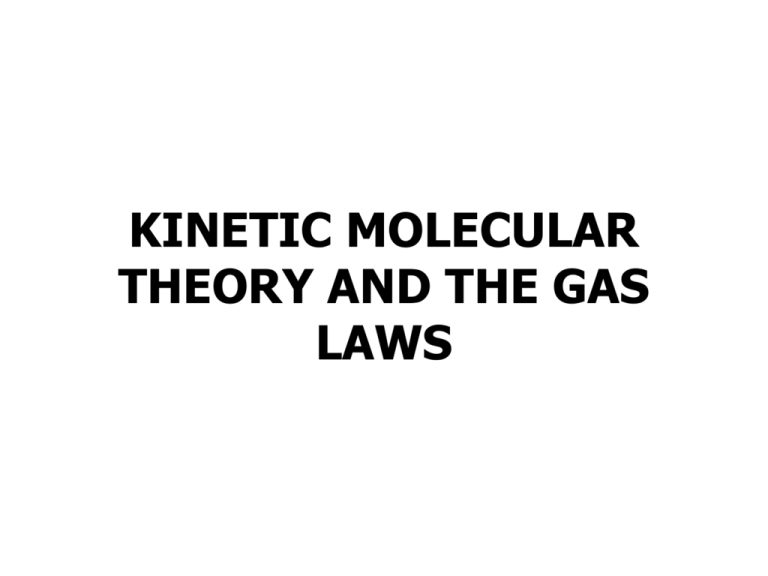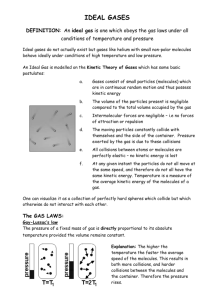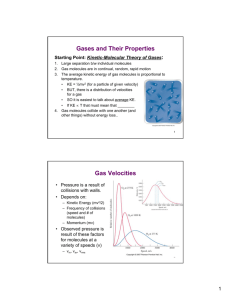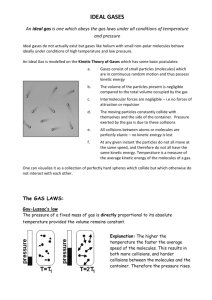
KINETIC MOLECULAR
THEORY AND THE GAS
LAWS
KINETIC MOLECULAR THEORY
Kinetic Molecular Theory
Postulates of the Kinetic Molecular Theory of Gases
1.
Gases consist of tiny particles (atoms or molecules) These particles are so
small, compared with the distances between them, that the volume (size) of
the individual particles can be assumed
to be negligible (zero).
2.
The particles are in constant random motion, colliding with the walls of
the container. These collisions with the walls cause the pressure exerted
by the gas.
3.
Molecular collisions are elastic. This means that although individual
molecules may gain or lose kinetic energy, there is no net (overall) gain or
loss of kinetic energy from these collisions.
4.
The average kinetic energy of the gas particles is directly proportional
to the Kelvin temperature of the gas
KMT Postulate 1
Gases consist of tiny particles (atoms or molecules) These
particles are so small, compared with the distances
between them, that the volume (size) of the individual
particles can be assumed to be negligible (zero).
o
o
o
KMT Postulate 2
The particles are in constant random motion,
colliding with the walls of the container.
These collisions with the walls cause the
pressure exerted by the gas.
Collisions of Gas Particles
Kinetic Theory
KMT Postulate 3
Molecular collisions are elastic. This means
that although individual molecules may
gain or lose kinetic energy, there is no
net (overall) gain or loss of kinetic energy
from these collisions.
- There are no attractive forces between
molecules
solids
liquids
gases
Elastic vs. Inelastic Collisions
8
3
Elastic vs. Inelastic Collisions
v1
POW
v2
8
elastic collision
v3
v4
8
inelastic collision
Elastic Collision
v1
8
before
8
after
v2
KMT Postulate 4
The average kinetic energy of the gas
particles is directly proportional to the
Kelvin temperature of the gas
Kinetic Molecular Theory (KMT)
explains why gases behave as they do
deals w/“ideal” gas particles…
1.
…are so small that they are assumed to have zero volume
2. …are in constant, straight-line motion
3. …experience elastic collisions in which no energy is lost…have
no attractive or repulsive forces toward each other
4. …have an average kinetic energy (KE) that is proportional
to the absolute temp. of gas (i.e., Kelvin temp.)
AS TEMP.
, KE
VARIABLES OF GAS LAWS
Volume
Temperature
Mole
Pressure
VARIABLES OF GAS LAWS
• Volume – three-dimensional space that
matter occupies
• Temperature - property of matter which
reflects the quantity of kinetic energy of
the component particles
• Pressure – force exerted by particles on a
specific area
• Mole – the unit of counting molecules,
atoms or any particle.
Temperature
Always use absolute temperature (Kelvin)
when working with gases.
ºF
-459
ºC
-273
K
0
C F 32
5
9
32
212
0
100
273
373
K = ºC + 273
Courtesy Christy Johannesson www.nisd.net/communicationsarts/pages/chem
Pressure
force
pressure
area
Which shoes create the most pressure?
Courtesy Christy Johannesson www.nisd.net/communicationsarts/pages/chem
Pressure
Pressure occurs when a force is
dispersed over a given surface area.
P=
Mass: 2000 kg
Foot area: 5000 cm2
F
A
If F acts over a large area…
But if F acts over a small area…
F =
P
A
F =
A
P
55 kg
60 cm2
Gases exert
pressure in all
directions and is
often measured
with a barometer
Atmospheric
pressure changes
with altitude:
as altitude
, pressure
Pressure and Temperature
STP (Standard Temperature and Pressure)
standard temperature
0 oC
273 K
standard pressure
1 atm
101.3 kPa
760 mm Hg
Equations / Conversion Factors:
K = oC + 273
oC = K – 273
C = (5/9)*(F-32)
F = (9/5)*C+32
1 atm = 101.3 kPa = 760 mm Hg
Properties of Gases
Gas properties can be modeled using math.
Model depends on:
V = volume of the gas (liters, L)
T = temperature (Kelvin, K)
P = pressure (atmospheres, atm, torr,
kPa)
n = amount (moles, mol)
Volume and Number of Moles
n =3
n =2
n =1
V
Zumdahl, Zumdahl, DeCoste, World of Chemistry 2002, page 413
2V
3V
A Gas Sample is Compressed
Zumdahl, Zumdahl, DeCoste, World of Chemistry 2002, page 429
Avogadro's Hypothesis
Equal volumes of gases at the same T and P
have the same number of molecules.
V = kn
This means, for example, that
number of moles goes up as volume goes up.
V and n are directly related.
*Amedeo Avogadro
(1776 - 1856)
twice as many molecules
1 mole = 6.022 x 1023
*Lorenzo Romano Amedeo Carlo Avogadro, conte di Quaregna e Cerreto
Avogadro’s Hypothesis
N2
H2
Ar
CH4
At the same temperature and pressure, equal volumes of
different gases contain the same number of molecules.
Each balloon holds 1.0 L of gas at 20oC and 1 atm pressure.
Each contains 0.045 mol or 2.69 x 1022 molecules of gas.
Molar Volume
1 mol of a gas @ STP has a volume of 22.4 L
P = 1 atm
nO 2= 1 mole
(32.0 g)
VO 2= 22.4 L
Timberlake, Chemistry 7th Edition, page 268
273 K
P = 1 atm
P = 1 atm
nHe2= 1 mole
(4.0 g)
nN 2= 1 mole
(28.0 g)
VHe 2= 22.4 L
273 K
VN 2= 22.4 L
273 K
V vs. n (Avogadro’s hypothesis)
At constant pressure and
temperature, volume increases
as amount of gas increases
(and vice versa).
V1 = kn1
V2 = kn2
V1/n1= V2/n2
Copyright ©2007 Pearson Benjamin Cummings. All rights reserved.
Volume vs. Quantity of Gas
26
24
22
1 mole = 22.4 L @ STP
Volume (L)
20
18
16
14
12
10
The graph shows there is a direct
relationship between the volume
and quantity of gas.
Whenever the quantity of gas is
increased, the volume will increase.
8
6
4
2
0
0.2
0.4
0.6
Number of moles
0.8
1.0
Same Gas,
Volume, and
Temperature,
but…
Dorin, Demmin, Gabel, Chemistry The Study of Matter , 3rd Edition, 1990, page 316
Same Gas,
Volume, and
Temperature,
but…
different
numbers of
moles
Dorin, Demmin, Gabel, Chemistry The Study of Matter , 3rd Edition, 1990, page 316
Adding and Removing Gases
100 kPa
200 kPa
200 kPa
Decreasing Pressure
100 kPa
If you double the number
of molecules
1 atm
http://www.tvgreen.com/chapt14/Chapt14.ppt#262,8,Slide 8
If you double the number of
molecules…
You double the pressure.
2 atm
As you remove molecules
from a container the
pressure decreases.
4 atm
As you remove molecules
from a container the
pressure decreases.
4 atm
1 atm
• As you remove molecules
from a container the pressure
decreases
• Until the pressure inside
equals the pressure outside
• Molecules naturally move
from high to low pressure
Boyle’s Law
Boyle’s Law
At a constant temperature, the product of
the pressure and the volume of a gas
sample is a constant value.
Condition 2
Condition 1
P1V1 = K
P2V2 = K
P1V1 = P2V2
Problem Solving
If 35 mL of oxygen gas is compressed from
1,900 torr pressure to 1.8 atm pressure,
what is the new volume at constant
temperature?
Step 1: Identify the variables
(Given)
Given:
Initial Conditions
P1 = 1,900 torr
V1 = 35 mL
Convert to uniform units
1.8 atm x 760 torr =
1 atm
Final Conditions
P2 = 1.8 atm
V2 = ?
1368 torr
Step 2: Identify what is Required
and state the appropriate equation
Required:
The volume at the final condition (V2)
Equation:
From Boyle’s Law, P1V1 = P2V2
V2 = P1V1
P2
Step 3: Substitute and do the Math
Solution:
V2 = P1V1
P2
= 1900 torr (35 mL)
1368 torr
Answer:
49 mL of oxygen
= 48.6111111 ml
Your Turn
• Where is this principle applicable?
Explain.
Charles’ Law
k
At constant pressure, the volume of a given
gas sample divided by its Kelvin
temperature is a constant value.
V
T
10
10
(a)
(b)
original temperature
original pressure
original volume
increased temperature
original pressure
increased volume
Dorin, Demmin, Gabel, Chemistry The Study of Matter , 3rd Edition, 1990, page 323 (newer book)
Initial Condition
Final Condition
V1 / T1= k
V2 / T2 = k
V1/T1 = V2/T2
Problem Solving
If the temperature of a 12L gas sample
increases from 32C to 60C, what will
happen to the volume of the gas?
Step 1: Identify the variables
(Given)
Given:
Initial Conditions
T1 = 32C
V1 = 12L
Convert to standard units
T1 = 32C + 273 = 305 K
T2 = 60C + 273 = 333 K
Final Conditions
T2 = 60C
V2 = ?
Step 2: Identify what is Required
and state the appropriate equation
Required:
The volume at the final condition (V2)
Equation:
From Charles’ Law, V1/T1 = V2/T2
V2 = T2V1
T1
Step 3: Substitute and do the Math
Solution:
V2 = T2V1
T1
= 333 K (12L)
305 K
Answer:
13 L
= 13.1016393442 L
Your Turn
• Where is this principle applicable?
Explain.
Gay Lussac’s Law
• At constant volume, the pressure of a
given gas sample divided by its Kelvin
temperature is a constant value
• V1/T1= k
P
• V1/T1= V2/T2
T
Problem Solving
• 10.0 L of a gas is found to exert 97.0 kPa
at 25.0°C. What would be the required
temperature (in celcius) to change the
pressure to standard pressure?
Step 1: Identify the variables
(Given)
Given:
Initial Conditions
T1 = 25.0°C
P1 = 97.0 kPa
Convert to standard units
T1 = 25C + 273 = 298 K
Final Conditions
T2 = ?
P2 = 101.3 kPa
Gas Stoich
• Because 1 mol of any gas at STP
occupies 22.4 L we can now solve for the
volume of a gas in a reaction using stoich.
• Refer to pp 141 of packet.








